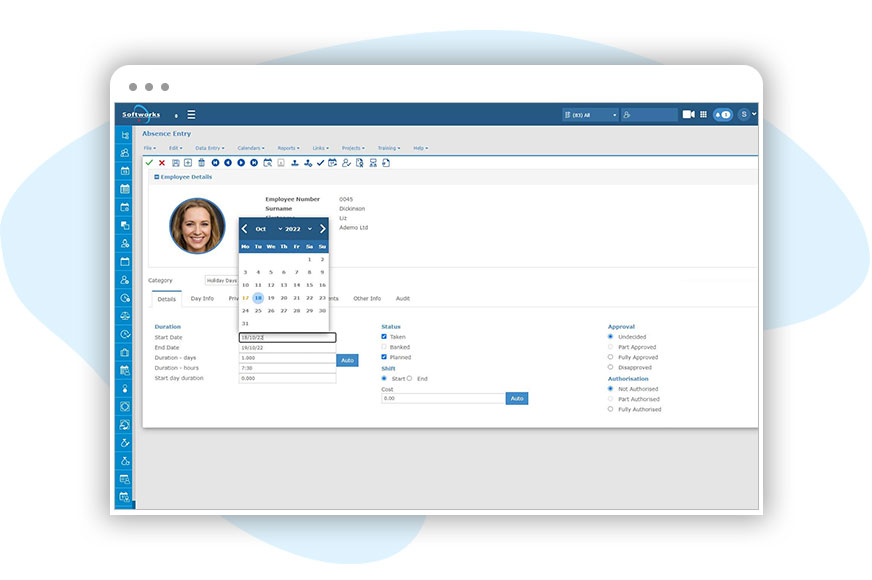Workforce management refers to the system of processes involved in the daily organisation and operation of employees in a working environment. In any organisation that has multiple departments with multiple employees, there is going to be a certain amount of difficulty and complexity in the management of these employees. Some of the most common challenges in workforce management include Scheduling and Rostering, Time & Attendance Tracking, Managing Absences and Employee Self-Service.
Let’s take a further look at top 5 workforce management challenges:
1. Time & Attendance Tracking
The main issues surrounding tracking employee time and attendance in any organisation typically result from the tracking being paper-based, with employees manually signing in and out using Timesheets. Effective time and attendance tracking is essential for managing workforce productivity, compliance, and payroll accuracy. Traditional paper-based methods are prone to errors and require manual processing, which can be time-consuming and inefficient.
In contrast, digital and automated clocking systems offer a more reliable, accurate, and efficient way of tracking employee hours. They can also provide real-time visibility into employee attendance, overtime, and breaks, which can help managers make informed decisions about staffing and scheduling. By automating time and attendance tracking, companies can streamline their operations, reduce costs, and improve employee satisfaction.
In addition to the challenges of paper-based timesheets, inaccurate time and attendance records can lead to payroll errors, which can negatively impact employee morale and lead to potential legal issues. Automated time and attendance systems can help to reduce the risk of errors and ensure accurate and timely payroll processing.
2. Scheduling and Rostering
Managing complex shift patterns and staffing levels can be a significant challenge for companies with multiple departments and employees. Manual rostering processes can be time-consuming, error-prone, and difficult to coordinate, especially when dealing with multiple locations, skill sets, and employee preferences. Automated rostering solutions can simplify this process by using rule-based scheduling algorithms to optimize shift patterns, manage leave requests, and track availability. By automating rostering, companies can reduce costs, minimize conflicts, and increase employee satisfaction.
Proper scheduling and rostering are crucial to ensure that there are enough employees on shift to meet customer demand while also avoiding overstaffing. This can be a delicate balance, particularly in industries where demand can fluctuate based on factors such as seasonality or current events. Automated scheduling tools can help managers to create optimal schedules and ensure that they are being adhered to by employees.
3. Managing Absences
Absences can be a significant source of disruption for businesses, particularly if they are not managed effectively. However, it is important to differentiate between planned and unplanned absences and handle them appropriately. For planned absences, it may be necessary to adjust schedules and staffing levels to ensure that essential functions are still being carried out. For unplanned absences, contingency plans should be in place to ensure that essential functions can continue without interruption.
To manage absences effectively, companies need to have robust absence management systems in place that provide real-time visibility into employee availability, leave balances, and the reasons for absence. Such systems can help companies reduce absenteeism, improve compliance, and increase employee engagement by offering flexible and supportive work arrangements. It can also drastically reduce Absence management administration and greatly improve reaction time in case of unplanned absences.
4. Employee Self-Service
The increasing demand from employees for access to their time & attendance information and data is presenting a challenge for employers who still store this data in paper format. The requirement for transparency around employee data is difficult to comply with for employers who do not have this information stored digitally. Employee self-service (ESS) solutions can provide a wide range of benefits for both employers and employees. By allowing employees to access their own data, including timesheets, schedules, and leave requests, employers can reduce the workload on HR departments and improve employee engagement.
Self-service portal and mobile app offer a convenient and secure way for employees to view and update their information, request leave, swap shifts, request absence or annual leave and much more. By giving employees more control over their work-life balance and information, self-service solutions can improve employee satisfaction, reduce administrative workload, and increase communication and transparency between employees and management.
5. Holiday Tracking
Managing employee leave requests can be a challenging task, particularly in industries where there is a high demand for leave during certain periods. Chances are, employees are going to want to take annual leave during the summer months when the weather is fine. Demand for time off mid-year is going to be very high. Unfortunately, it will not be possible to accommodate everyone’s holiday requests at the same time and it is often necessary to stagger these requests to ensure that the company still functions fully.
Effective holiday tracking is crucial for managing staff levels and ensuring adequate staffing during peak periods. However, managing high demand for annual leave can be challenging, especially when dealing with multiple requests and competing priorities. To manage holiday requests effectively, companies need to have clear policies and guidelines in place that balance the needs of the business with the preferences of employees. Companies can also incentivize and encourage employees to take time off by offering flexible work arrangements, wellness programs, and other benefits that promote work-life balance. By prioritizing employee well-being and holiday management, companies can improve employee satisfaction and retention, reduce absenteeism, and increase productivity.
Automated holiday tracking systems can help managers to more efficiently manage leave requests and ensure that essential functions are still being carried out during periods of high demand. These systems can also help to reduce the risk of scheduling conflicts and ensure that all employee requests are handled fairly and transparently.
Learn more: How to Track Holidays with Softworks?
Conclusion
In today’s fast-paced and highly competitive business environment, organizations need to be agile and efficient to stay ahead of the curve. Workforce management solutions offer an effective way to achieve this goal by optimizing employee output and performance. By automating and streamlining key workforce management processes such as time and attendance tracking, scheduling and rostering, managing absences, and holiday tracking, businesses can reduce administrative burdens, cut costs, and improve overall business performance.
Moreover, workforce management solutions can provide valuable insights into employee productivity and help identify areas for improvement. By leveraging the power of workforce management solutions, companies can stay ahead of the competition, drive growth, and achieve long-term success. Therefore, it is essential for businesses of all sizes and across all industries to invest in robust and effective workforce management solutions to unlock the full potential of their employees and maximize their bottom line.














